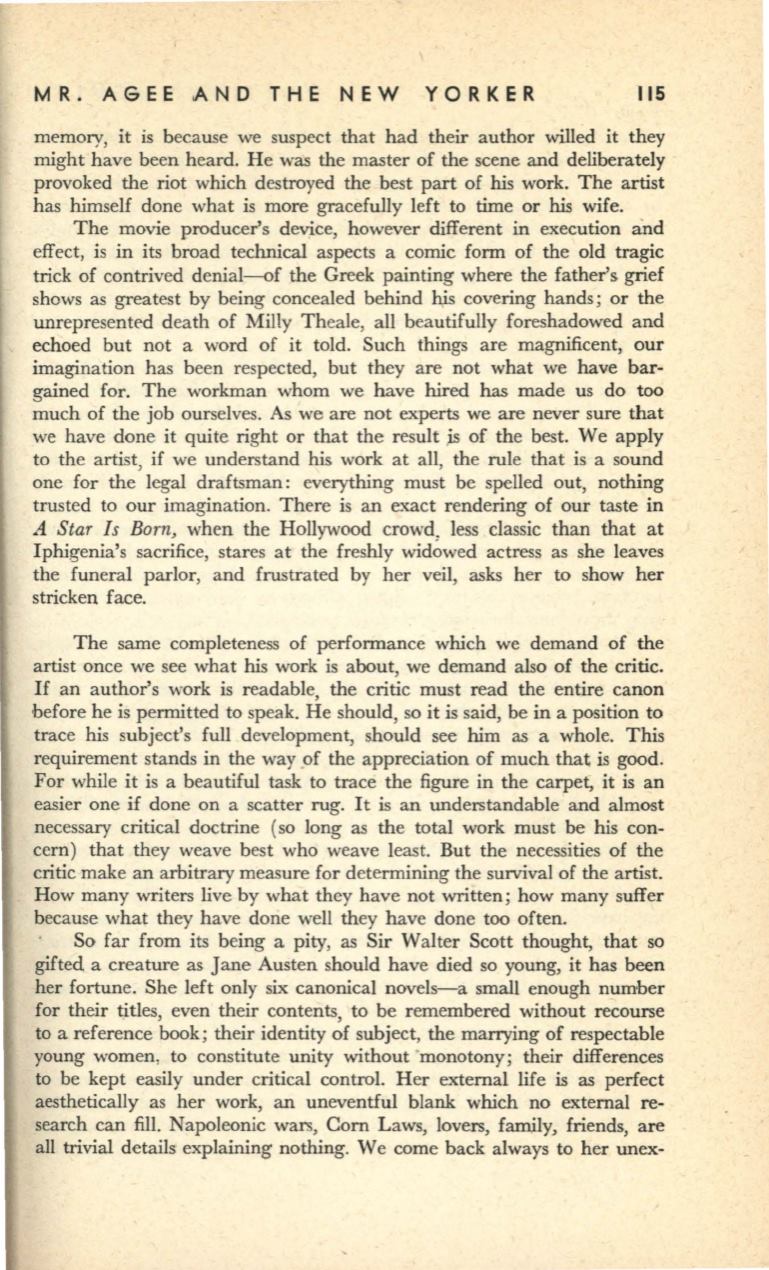
MR. AGEE AND THE NEW YORKER
115
memory, it is because we suspect that had their author willed it they
might have been heard. He was the master of the scene and deliberately
provoked the riot which destroyed the best part of his work. The artist
has himself done what is more gracefully left to time or
his
wife.
The movie producer's dev,ice, however different
in
execution and
effect, is in its broad technical aspects a comic form of the old tragic
trick of contrived denial--of the Greek painting where the father's grief
shows as greatest by being concealed behind h,is covering hands; or the
unrepresented death of Milly Theale, all beautifully foreshadowed and
echoed but not a word of
it
told. Such things are magnificent, our
imagination has been respected, but they are not what we have bar–
gained for. The workman whom we have hired has made us do too
much of the job ourselves. As we are not experts we are never sure that
we have done it quite right or that the result
,is
of the best. We apply
to the artist, if we understand his work at all, the rule that is a sound
one for the legal draftsman: everything must be spelled out, nothing
trusted to our imagination. There is an exact rendering of our taste in
A Star Is Born,
when the Hollywood crowd. less classic than that at
Iphigenia's sacrifice, stares at the freshly widowed actress as she leaves
the funeral parlor, and frustrated by her veil, asks her to show her
stricken face.
The same completeness of performance which we demand of the
artist once we see what his work is about, we demand also of the critic.
If
an author's work is readable, the critic must read the entire canon
before he is permitted to speak. He should, so it is said, be in a position to
trace
his
subject's full development, should see him as a whole. This
requirement stands in the way of the appreciation of much that
is
good.
For while it is a beautiful task to trace the figure in the carpet, it is an
easier one if done on a scatter rug. It is an understandable and almost
necessary critical doctrine (so long as the total work must be his con–
cern) that they weave best who weave least. But the necessities of the
critic make an arbitrary measure for determining the survival of the artist.
How many writers live by what they have not written; how many suffer
because what they have done well they have done too often.
So far from its being a pity, as Sir Walter Scott thought, that so
gifted, a creature as Jane Austen should have died so young, it has been
her fortune. She left only six canonical novels-a small enough number
for their t.itles, even their contents, to be remembered without recourse
to a reference book; their identity of subject, the marrying of respectable
young women, to constitute unity without monotony; their differences
to be kept easily under critical control. Her external life
is
as perfect
aesthetically as her work, an uneventful blank which no external re–
search can fill. Napoleonic wars, Corn Laws, lovers, fam,ily, friends, are
all trivial
detail~
explaining nothing. We come back always to her unex-


